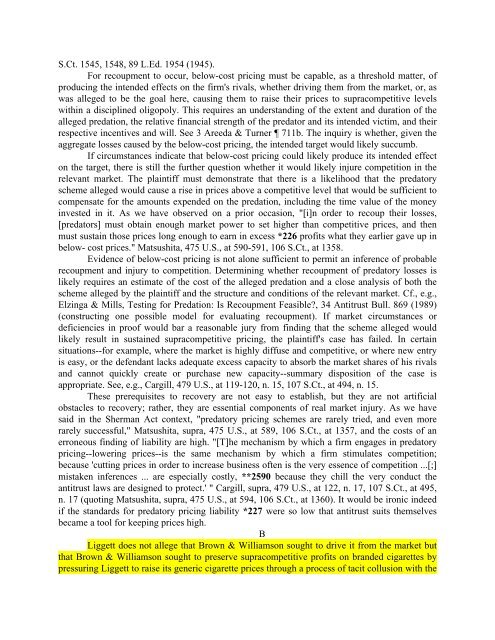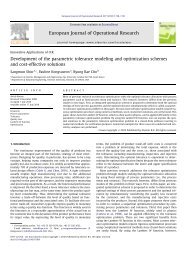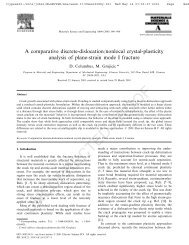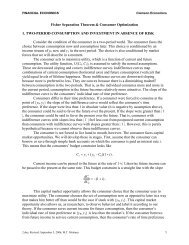509 U.S. 209, 113 S.Ct. 2578 BROOKE GROUP LTD., Petitioner v ...
509 U.S. 209, 113 S.Ct. 2578 BROOKE GROUP LTD., Petitioner v ...
509 U.S. 209, 113 S.Ct. 2578 BROOKE GROUP LTD., Petitioner v ...
You also want an ePaper? Increase the reach of your titles
YUMPU automatically turns print PDFs into web optimized ePapers that Google loves.
S.<strong>Ct</strong>. 1545, 1548, 89 L.Ed. 1954 (1945).<br />
For recoupment to occur, below-cost pricing must be capable, as a threshold matter, of<br />
producing the intended effects on the firm's rivals, whether driving them from the market, or, as<br />
was alleged to be the goal here, causing them to raise their prices to supracompetitive levels<br />
within a disciplined oligopoly. This requires an understanding of the extent and duration of the<br />
alleged predation, the relative financial strength of the predator and its intended victim, and their<br />
respective incentives and will. See 3 Areeda & Turner 711b. The inquiry is whether, given the<br />
aggregate losses caused by the below-cost pricing, the intended target would likely succumb.<br />
If circumstances indicate that below-cost pricing could likely produce its intended effect<br />
on the target, there is still the further question whether it would likely injure competition in the<br />
relevant market. The plaintiff must demonstrate that there is a likelihood that the predatory<br />
scheme alleged would cause a rise in prices above a competitive level that would be sufficient to<br />
compensate for the amounts expended on the predation, including the time value of the money<br />
invested in it. As we have observed on a prior occasion, "[i]n order to recoup their losses,<br />
[predators] must obtain enough market power to set higher than competitive prices, and then<br />
must sustain those prices long enough to earn in excess *226 profits what they earlier gave up in<br />
below- cost prices." Matsushita, 475 U.S., at 590-591, 106 S.<strong>Ct</strong>., at 1358.<br />
Evidence of below-cost pricing is not alone sufficient to permit an inference of probable<br />
recoupment and injury to competition. Determining whether recoupment of predatory losses is<br />
likely requires an estimate of the cost of the alleged predation and a close analysis of both the<br />
scheme alleged by the plaintiff and the structure and conditions of the relevant market. Cf., e.g.,<br />
Elzinga & Mills, Testing for Predation: Is Recoupment Feasible?, 34 Antitrust Bull. 869 (1989)<br />
(constructing one possible model for evaluating recoupment). If market circumstances or<br />
deficiencies in proof would bar a reasonable jury from finding that the scheme alleged would<br />
likely result in sustained supracompetitive pricing, the plaintiff's case has failed. In certain<br />
situations--for example, where the market is highly diffuse and competitive, or where new entry<br />
is easy, or the defendant lacks adequate excess capacity to absorb the market shares of his rivals<br />
and cannot quickly create or purchase new capacity--summary disposition of the case is<br />
appropriate. See, e.g., Cargill, 479 U.S., at 119-120, n. 15, 107 S.<strong>Ct</strong>., at 494, n. 15.<br />
These prerequisites to recovery are not easy to establish, but they are not artificial<br />
obstacles to recovery; rather, they are essential components of real market injury. As we have<br />
said in the Sherman Act context, "predatory pricing schemes are rarely tried, and even more<br />
rarely successful," Matsushita, supra, 475 U.S., at 589, 106 S.<strong>Ct</strong>., at 1357, and the costs of an<br />
erroneous finding of liability are high. "[T]he mechanism by which a firm engages in predatory<br />
pricing--lowering prices--is the same mechanism by which a firm stimulates competition;<br />
because 'cutting prices in order to increase business often is the very essence of competition ...[;]<br />
mistaken inferences ... are especially costly, **2590 because they chill the very conduct the<br />
antitrust laws are designed to protect.' " Cargill, supra, 479 U.S., at 122, n. 17, 107 S.<strong>Ct</strong>., at 495,<br />
n. 17 (quoting Matsushita, supra, 475 U.S., at 594, 106 S.<strong>Ct</strong>., at 1360). It would be ironic indeed<br />
if the standards for predatory pricing liability *227 were so low that antitrust suits themselves<br />
became a tool for keeping prices high.<br />
B<br />
Liggett does not allege that Brown & Williamson sought to drive it from the market but<br />
that Brown & Williamson sought to preserve supracompetitive profits on branded cigarettes by<br />
pressuring Liggett to raise its generic cigarette prices through a process of tacit collusion with the
















